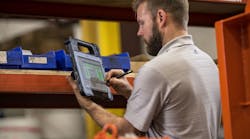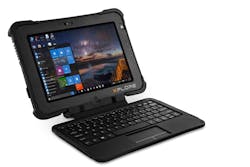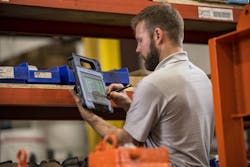In this era of information overload, misconceptions and misinformation are running rampant. Just because a product claims to have a certain characteristic or specification, it doesn’t make it true. For instance, when you hear something is “rugged,” does that mean it is strong? Or, does it mean it’s built for the outdoors? Does it mean it’s only for workers in the field? Such questions cloud the rugged device industry.
Also, many misconceptions exist between rugged devices and consumer devices. For instance, is a rugged tablet all that different from a consumer device with a good case? Most industry outsiders think that rugged mobile devices are simply consumer products with protective cases. However, this notion could not be further from the truth. The fact is that they are their own class—a special breed of devices created for the toughest, harshest, most rugged working environments.
From extreme temperatures, to wet or dusty environments, and back to the office again, rugged mobility devices are built from the inside out to tolerate far more hazards than consumer devices. These include the drops, fluid contaminant exposure, and vibrations that are often encountered by manufacturing, transportation, utility, and construction industry workers.
The Rugged Ratings
Unlike one-size-fits-all consumer products, rugged mobile devices are purposefully built to meet minimum industry-standard specifications—standards that far exceed those applied to consumer and commercial-grade devices. However, not all rugged devices are created equal. In fact, the only “one-size-fits-all” characteristic that inherently rugged devices share is their rigorous testing practices.
Truly rugged tablet, handheld, and 2-in-1 mobile computers will be able to demonstrate their resiliency against a variety of environmental elements via both lab and field testing. The two most important methods of determining “ruggedness” are the U.S. Department of Defense “Test Method Standard for Environmental Engineering Considerations and Laboratory Tests,” commonly referred to as MIL-STD-810G and the Ingress Protection (IP) rating system. These ratings and standards provide independent and objective criteria with which to grade specific characteristics of a rugged computer.
MIL-STD-810G tests are designed specifically to gauge the performance levels of rugged tablets—and other mobile computers—in a variety of harsh environments. MIL-STD-810G testing ensures that rugged devices can withstand drops, vibrations, crashes, extreme temperatures, differing altitudes, and natural elements such as wind, rain, sand, humidity and dust. Judging by the amount of screen repair shops there are on every corner, you can imagine consumer devices don’t meet such stringent design standards.
Along with MIL-STD-810G ratings, rugged devices are given an IP rating, which denotes the effectiveness of a computer’s rugged casing at preventing solids and liquids from reaching its easily damaged internal parts. These ratings provide device users with an idea of what hazardous environments the devices can handle.
To be considered “fully rugged,” a device must be rated at a minimum of IP54, which means that a device offers a tough layer of water protection and dust protection to keep minor interactions in a typical working environment from becoming major challenges. However, since most industrial environments involve conditions that are more hostile than this rating will protect against, it’s recommended that devices being used in harsh environments have a rating of IP65.
An IP65 rating will ensure that the device is completely protected against dust contact and ingress. It will also enable the device to withstand the impact of low-pressure water jets projected by a nozzle (6.3 mm) from any direction for at least 15 minutes. This is often more than sufficient for most working conditions.
For those who anticipate more extreme water exposure, an IP68 device is recommended as it can be submersed beyond 1 m for up to 30 minutes without shutting down. In other words, your workers can take these most rugged mobile computers into the middle of the desert or deep into flooded areas without having to wait for the waters to recede.
Just remember: A higher IP rating doesn’t mean that one device is more rugged than another, or that it’s truly rugged. For example, an increasing number of consumer devices are rated IP67 or IP68. Yet, they rarely have more than a single USB port, if they have any I/O ports at all. Thus, designing those devices against ingress protection isn’t as big of a challenge. However, devices used for professional purposes require a significant number of I/O to support industry applications and interface with specialized equipment and machinery. Consequently, it takes great deal of engineering to design ingress protection into truly rugged devices.
Look Beyond the Surface: Understanding the Rugged Design
Though it may be tempting to take a device’s rugged specs at face value, it’s important to understand the rugged design of a device when trying to determine its true performance, reliability, and longevity capabilities. While rugged devices are always designed differently than consumer-grade technology to meet both the MIL-STD-810G and IP rating standards, not all rugged devices are designed to the same quality standards—starting with the core materials used.
Most consumer devices have aluminum or steel cores, which are moderately sturdy in their own right, but will certainly falter under extreme pressure. In contrast, top-performing rugged devices are designed with magnesium alloy cores, which not only are lightweight, but field-proven to withstand incredible pressure and shock from drops, hits and bumps (Fig. 1). In addition, the best rugged devices will be constructed with bright displays that incorporate anti-smudge and anti-reflective technology to enable easy high-definition viewing of detailed documents and images day or night, as well as thin, yet heavy-duty, glass to provide additional screen protection against drops or other impacts.
1. The Xplore XBOOK L10 boasts some of the fastest speeds of any rugged devices. It has Android and Windows operating-system capabilities, putting its performance on par with consumer devices.
Even more noticeable when comparing consumer and rugged devices, as well as competing rugged devices, will be the emphasis that high-quality rugged-device engineers place on antenna design and placement and power-related enhancement features. Those who design mobility solutions for field-service and industrial environments understand that reliable wireless connectivity in dense, remote, and “network fringe” areas is quickly becoming table stakes. Workers need to be able to connect to data and applications everywhere they go.
Then there are some qualities of rugged devices that consumer devices don’t even offer. Barcode readers, hot-swappable batteries, fingerprint sensors, and specialized docking mounts are just a few of the industrialized offerings for rugged devices. Most consumer devices will only have options for a case and headphones, or perhaps a merchant might have a credit-card-reader attachment.
Unlike consumer add-ons, the accessories for rugged devices are key to work performance, as they take the devices from great computers to versatile, all-in-one ecosystems. So are the extensive I/O ports that are built into many rugged devices. While most consumer devices are reducing I/O down to an audio jack and, if you’re lucky, a USB or microUSB port, many rugged tablets and 2-in-1s are now offering up to eight standard I/O ports, including HDMI-In and True Serial options. That doesn’t include the additional port availability with the accompanying docks. To take it a step further, manufacturers are even sealing many of these ports to maintain IP levels when the ports are open.
And, underneath all of the ruggedness lies components that exceed the performance of top consumer devices, such as faster connection speeds for uploading and downloading content and storage capabilities of up to 1 TB. Some rugged devices offer pass-through wireless antenna to support MIMO, WWAN, and GPS simultaneously, and cellular support for frequency bands often required for public safety and other critical applications. These components and capabilities are just some of the reasons why the rugged-device market, which is expected to grow at a CAGR of almost 7% between 2018-2020, is outpacing the market growth for consumer devices, which has declined for 12 consecutive quarters.
Rugged Doesn’t Mean Rigid
Through rugged devices may be engineered for extreme working conditions (Fig. 2), that doesn’t translate into not being able to perform many of the same tasks as consumer devices. From running Windows and Android software applications, to surfing the internet, rugged mobile computers such as tablets and 2-in-1s have all of the day-to-day functionality you would need in an office setting, making them both versatile and highly-functional. They can be used in the field to write reports, send email, search for information on the internet, connect to other operational and peripheral equipment, take photos, and much more.
2. Rugged devices are built for tough working environments while maintaining a great standard of operability.
The misconception that rugged means bare-bones—that the quality of the user experience or the device design has to be sacrificed for extra protection—is simply false. Rugged devices are a valuable solution for many industry verticals that require mobile technology interoperability with operational equipment and back-office systems. They offer similar user experiences to consumer devices with the added protection against the tough environmental hazards that come with the job they’re asked to do.
Gone are the days of brick-like devices that could only be used for basic computing functions before being quickly phased out by newer models. For extreme working environments that demand tough technology, today’s rugged devices have been purposely designed so that generational upgrades can be done seamlessly to extend the life of the technology. That means they have a lower total cost of ownership when compared to non-rugged devices. With expandable storage and memory, powerful processors, and multiple feature options, modern rugged computing devices allow for flexibility and growth as business demands evolve to support the rapidly growing mobile workforce.
Plus, the rugged mobile device industry has been around for over 20 years, as compared to the consumer mobile devices that have really come about in the last 10 years. There’s simply more experience, knowledge, and IP behind today’s leading rugged devices when compared to many of the trendy consumer devices. If you want a mobility solution that is going to meet or exceed your performance, durability, security, and connectivity standards—and you want a versatile platform that can support your many different mobile workers—then you need a truly rugged tablet, 2-in-1 or handheld.
Tom McNeela is SeniorDirector of Enterprise Mobile Computing Product Management at Zebra Technologies.



